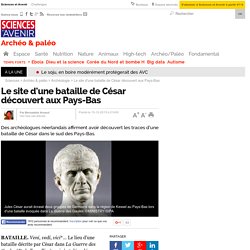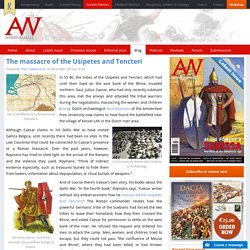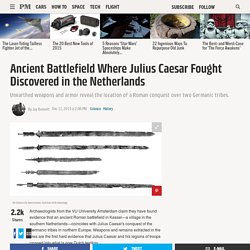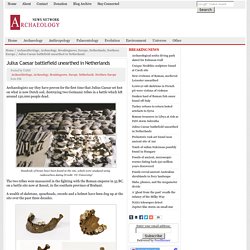

Le site d'une bataille de César découvert au Pays-Bas. BATAILLE.

Veni, vedi, vici*… Le lieu d’une bataille décrite par César dans La Guerre des Gaules (De bello gallico), qui s’est déroulée sur un territoire jusqu’alors non identifié, aurait été retrouvé dans les régions de Kessel et Heerewaarden, dans le Brabant septentrional (Pays-Bas). C’est ce qu’a affirmé le 11 décembre 2015 l’archéologue Nico Royman, de la Vrije Université (VU) d’Amsterdam. Le grand spécialiste néerlandais de l’Age du fer a en effet révélé la mise au jour sur place d’une importante quantité d’armes (épées, fers de lance) et surtout de restes humains datés du 1er siècle avant notre ère.
Ces vestiges marqueraient l’emplacement d’une bataille ayant eu lieu en 55 avant notre ère lors des guerres de conquête de Jules César, alors proconsul de Rome. Les os de la centaine de corps dégagée montreraient clairement des traces de blessures causées par des armes. Impitoyable destruction. Kessel (lieu de la bataille) Nico Roymans (VU University Amsterdam, Amsterdam) : l'inventeur. Telefoon:+31 20 59 86369 Kamernr:14a-00 E-mail:n.g.a.m.roymans@vu.nl Onderdeel:fac. der geesteswetenschappen ( gesch/oudh/k&c ) Functie:Chair: Westeuropean Archaeology (Archeologisch Centrum Vrije Universiteit -ACVU-) General Chair: Westeuropean Archaeology, Department of Archaeology, Classics and Ancient Studies Office hours: All days, except on Fridays Master’s programmes as well as research of the Department of Archaeology, Classics and Ancient Studies are organized within dynamic, international oriented knowledge centres.

Researchers participate in the research institute CLUE+ (for the heritage and history of Cultural Landsccapes and Urban Environment). The joint master’s programmes of VU University and the University of Amsterdam are provided by the Amsterdam Centre for Ancient Studies and Archaeology (ACASA). Research interests a. Teaching Research A. At this moment he is supervising the following research programme: F. Publications (selection) Principal books Roymans, N.
The massacre of the Usipetes and Tencteri - Ancient Warfare - Karwansaray Publishers. Posted by Theo Toebosch on 10 December 2015 at 10:59 In 55 BC, the tribes of the Usipetes and Tencteri, which had until then lived on the east bank of the Rhine, invaded northern Gaul.

Julius Caesar, who had only recently subdued this area, met the envoys and attacked the tribal warriors during the negotiations, massacring the women and children (story). Dutch archaeologist Nico Roymans of the Amsterdam Free University now claims to have found the battlefield near the village of Kessel-Lith in the Dutch river area. Although Caesar claims in his Gallic War to have visited Gallica Belgica, until recently there had been no sites in the Low Countries that could be connected to Caesar’s presence or a Roman massacre. César, Guerre des Gaules, IV,4,1-15 (récit de la bataille) Roman genocide: Battlefield where Julius Caesar slaughtered 150,000 tribespeople discovered in Netherlands.
A battlefield where Julius Caesar wiped out two Germanic tribes, killing around 150,000 people, has been discovered in the Netherlands.

Archaeologists at the VU University in Amsterdam announced evidence of weapons and skeletal remains that suggests the site near to where the Waal and Meuse rivers meet is where the bloody battle took place. Nico Roymans announced the findings at a press conference at the Allard Pierson Museum in Amsterdam. He said they had found skeletons, swords, spearheads and a helmet. Ancient Battlefield of Julius Caesar Discovered in the Netherlands. VU University Amsterdam, Institute of Archaeology Archaeologists from the VU University Amsterdam claim they have found evidence that an ancient Roman battlefield in Kessel—a village in the southern Netherlands—coincides with Julius Caesar's conquest of the Germanic tribes in northern Europe.

Weapons and remains extracted in the area are the first hard evidence that Julius Caesar and his legions of troops crossed into what is now Dutch territory. Advertisement - Continue Reading Below In addition to traditional archeological methods, researchers used carbon dating techniques to discover the age of multiple spearheads and swords, a helmet, belt hooks, and even skeletal remains. Julius Caesar battlefield unearthed in Netherlands. Archaeologists say they have proven for the first time that Julius Caesar set foot on what is now Dutch soil, destroying two Germanic tribes in a battle which left around 150,000 people dead.

The two tribes were massacred in the fighting with the Roman emperor in 55 BC, on a battle site now at Kessel, in the southern province of Brabant. A wealth of skeletons, spearheads, swords and a helmet have been dug up at the site over the past three decades. But now carbon dating as well as other historical and geo-chemical analysis had helped to prove they dated back to the 1st century BC, the Vrije Universiteit in Amsterdam said in a statement. "It is the first time that the presence of Caesar and his troops on Dutch soil has been explicitly shown," said archaeologist Nico Roymans.